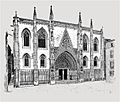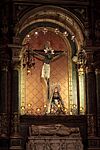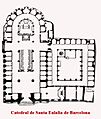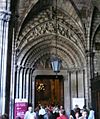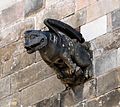Barcelona Cathedral facts for kids
Quick facts for kids Barcelona Cathedral |
|
|---|---|
| Metropolitan Cathedral Basilica of the Holy Cross and Saint Eulalia | |
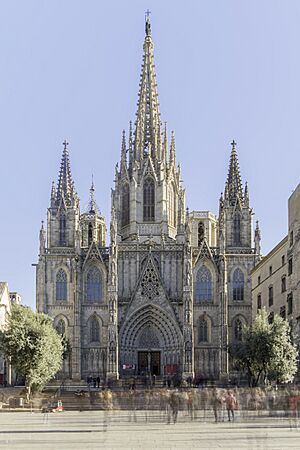
West façade in 2019.
|
|
| 41°23′02″N 2°10′35″E / 41.38389°N 2.17639°E | |
| Location | Barcelona |
| Country | Spain |
| Denomination | Catholic |
| History | |
| Status | Metropolitan Cathedral Basilica |
| Dedication | The Holy Cross and Saint Eulalia of Barcelona |
| Dedicated | 18 November 1058 |
| Architecture | |
| Architect(s) | Jaume Fabre (first known) |
| Style | Catalan Gothic, Gothic Revival |
| Groundbreaking | 1 May 1298 |
| Completed | 1913 (west façade and dome) |
| Specifications | |
| Length | 93 m (305 ft) |
| Width | 40 m (130 ft) |
| Nave height | 28 m (92 ft) |
| Dome height (outer) | 70 m (230 ft) |
| Dome height (inner) | 41 m (135 ft) |
| Tower height | 54 m (177 ft) |
| Administration | |
| Archdiocese | Barcelona |
The Barcelona Cathedral is a very old and important church in Barcelona, Spain. Its full name is the Cathedral of the Holy Cross and Saint Eulalia. It is the main church for the Archbishop of Barcelona.
This amazing building was mostly built between the 13th and 15th centuries. The beautiful courtyard, called a cloister, was finished in 1448. It has a special well called the Well of the Geese. Later, in the late 1800s, a new front (façade) was added in a style called neo-Gothic.
The cathedral is dedicated to the Holy Cross and Eulalia of Barcelona. Saint Eulalia is one of Barcelona's patron saints. She was a young girl who, according to stories, was martyred (killed for her beliefs) a long time ago. One story says that when she was put in the public square, a miracle happened: snow fell in spring to cover her. Another story says she was rolled down a street in a barrel with knives inside. Her remains are kept in the cathedral's crypt.
Inside the cathedral, you can see the coats-of-arms (family symbols) of knights from a group called the Order of the Golden Fleece. In 1519, Charles V, a powerful ruler, held an important meeting of this order here. The cathedral was big enough for the grand ceremonies.
There is also a special side chapel called the Chapel of the Holy Sacrament and of the Holy Christ of Lepanto. It holds a cross that is said to be from the time of a famous sea battle in 1571, the Battle of Lepanto.
Besides Saint Eulalia, other important people are buried here. These include Saint Olegarius, Saint Raymond of Penyafort, and Count Ramon Berenguer I with his wife.
The cathedral's quiet cloister is home to 13 white geese. People say this number represents Saint Eulalia's age when she was martyred.
Contents
History of the Cathedral
Early Churches on This Site
Before the current cathedral, there were other churches here. Archaeologists have found parts of very old Christian buildings, including a baptistery from the 4th century. There was also a church from the 6th or 7th century. This earlier church was badly damaged in 985 during an attack on Barcelona.
In 1046, Count Ramon Berenguer I and his wife, along with Bishop Guislabert, started building a new Romanesque-style cathedral. It was officially opened in 1058. This church was built over the underground crypt of the older church.
Building the Gothic Cathedral
The construction of the Gothic cathedral you see today began on May 1, 1298. James II the Just was the King of Aragon at that time. The church was built from the back towards the front. The main front part was finished in 1417.
The cloister, the peaceful courtyard, was completed in 1448. This means the main construction took about 150 years! Later, in the late 1800s, a wealthy person named Miguel Girona i Agrafel offered to pay for the completion of the neo-Gothic front and central tower. This work was finished in 1913 by his children.
Chapel of Lepanto
The Chapel of the Holy Sacrament and of the Holy Christ of Lepanto is a smaller chapel inside the cathedral. It was first built in 1407 and later rebuilt in the 1600s. It holds the tomb of Saint Olegarius, who was a bishop of Barcelona.
The famous "Holy Christ of Lepanto" crucifix is located above the entrance to this chapel. The statue of Jesus on the cross is curved. A Catalan legend explains why: it's said that this cross was on the front of a ship during the Battle of Lepanto in 1571. When a cannonball flew towards it, the cross leaned to avoid being hit, and it has stayed that way ever since! Another story says the figure moved to cover a hole in the ship, saving it from sinking.
Cathedral Architecture
Catalan Gothic Style
The Barcelona Cathedral is built in the Catalan Gothic style. This style is special to the Barcelona area. Catalan Gothic buildings often have open spaces and wide main areas. Unlike some other Gothic styles, it doesn't try to be super tall. Instead, it focuses on balancing the different parts of the building.
Size and Features
The Barcelona Cathedral is about 93 meters (305 feet) long and 40 meters (131 feet) wide. The central part of the church, called the nave, is 28 meters (91 feet) high. Each bell tower is 54 meters (177 feet) tall. The highest point of the cathedral, the dome, reaches 70 meters (229 feet) high.
The cathedral has three main sections, a choir area, and a cloister. The main section continues through to the choir. The side sections have chapels. There are large windows that open to the cloister, letting sunlight into the choir. Smaller windows above the chapels also bring in light. The front of the cathedral has a neo-Gothic design. You can see many sculptures of gargoyles and other creatures on the roof!
The Gothic Quarter
The Barcelona Cathedral is in the heart of Barcelona's Gothic Quarter. This area is known for its medieval buildings. From 1927 to 1970, many buildings in the Gothic Quarter were restored to look more Gothic. This was done to show Catalan pride and make the area more attractive.
The "Catalan house" was a key building that influenced the restoration of the whole neighborhood. Many buildings around the cathedral were either torn down or renovated to match the new Gothic style. This transformation gave Barcelona a historic look, connecting its past with its present-day tourism.
Traditions
- On the day of Corpus Christi, the cathedral celebrates the tradition of the 'dancing egg'. This is where an egg is balanced and spins on a jet of water from a fountain.
Present Day
Today, the Barcelona Cathedral has made some changes because many tourists visit it. The cloister now has a gift shop. Instead of traditional candles, visitors can light electronic candles at the shrines. To keep the chapels peaceful, cell phones are not allowed in places like the Chapel of Lepanto.
Images for kids
See also
 In Spanish: Catedral de la Santa Cruz y Santa Eulalia (Barcelona) para niños
In Spanish: Catedral de la Santa Cruz y Santa Eulalia (Barcelona) para niños
- Catholic Church in Spain
- List of Gothic Cathedrals in Europe


